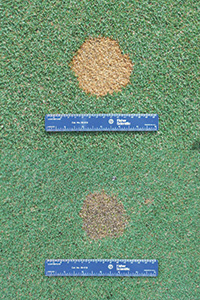Hydraulic oil spills on hybrid bermudagrass greens
By William L. Berndt, Ph.D.
 Hydraulic oil injures turf. Vegetable-based hydraulic oil is marketed as being less toxic to turf than petroleum-based hydraulic oil. If this is true, then healing times from vegetable-based hydraulic oil spills should be shorter.
Hydraulic oil injures turf. Vegetable-based hydraulic oil is marketed as being less toxic to turf than petroleum-based hydraulic oil. If this is true, then healing times from vegetable-based hydraulic oil spills should be shorter.
Research is being conducted at The Golf Club at Magnolia Landing Course in North Fort Myers, Fla. to determine healing times for spills of petroleum-based and vegetable-based hydraulic oil. When 3 mL (1 mL is equal to 0.2 teaspoon) of each oil was applied to Tifeagle hybrid bermudagrass mowed at 0.10 inches in December 2013, visible injury persisted for greater than 106 days. Injury area due to petroleum oil expanded to 8.4 square inches 36 days after application, then contracted to 3.6 square inches by 81 days after application.
Modeling indicated that the relationship between the injury area and the time predicted is a healing time of 108 days. In contrast, the injury area due to vegetable oil expanded to 6.2 square inches 10 days after application, contracting to 3.3 square inches 81 days after application with a predicted healing time of 115 days.
As of day 106, visible injury was still evident for both oils, though substantial healing had occurred. Reduced healing times were not observed for vegetable-based oil spills occurring during this minimal growth period. This experiment is being repeated during an active growth period, beginning March 2014. Additional research involving NDVI measurements and image analysis of hydraulic oil injury is also being conducted.
William L. Berndt, Ph.D., Florida Gulf Coast University, Fort Myers, Fla. Lee can be reached at leeberndt@aol.com for more information.
Photo: Lee Berndt








